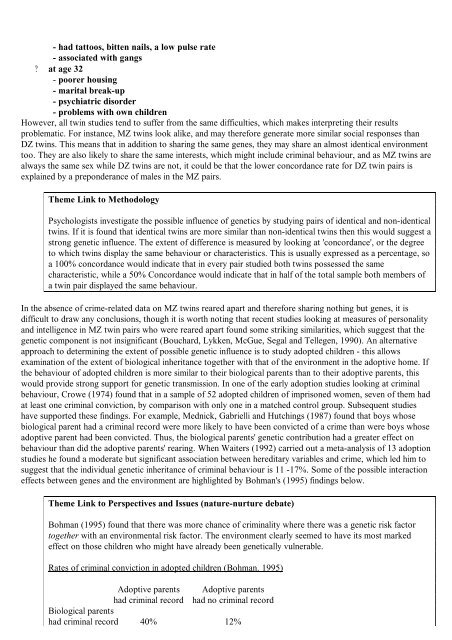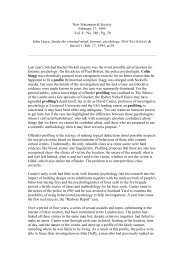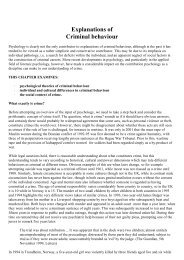Explanations of Criminal behaviour - Jeff Standen
Explanations of Criminal behaviour - Jeff Standen
Explanations of Criminal behaviour - Jeff Standen
Create successful ePaper yourself
Turn your PDF publications into a flip-book with our unique Google optimized e-Paper software.
- had tattoos, bitten nails, a low pulse rate<br />
- associated with gangs<br />
? at age 32<br />
- poorer housing<br />
- marital break-up<br />
- psychiatric disorder<br />
- problems with own children<br />
However, all twin studies tend to suffer from the same difficulties, which makes interpreting their results<br />
problematic. For instance, MZ twins look alike, and may therefore generate more similar social responses than<br />
DZ twins. This means that in addition to sharing the same genes, they may share an almost identical environment<br />
too. They are also likely to share the same interests, which might include criminal <strong>behaviour</strong>, and as MZ twins are<br />
always the same sex while DZ twins are not, it could be that the lower concordance rate for DZ twin pairs is<br />
explained by a preponderance <strong>of</strong> males in the MZ pairs.<br />
Theme Link to Methodology<br />
Psychologists investigate the possible influence <strong>of</strong> genetics by studying pairs <strong>of</strong> identical and non-identical<br />
twins. If it is found that identical twins are more similar than non-identical twins then this would suggest a<br />
strong genetic influence. The extent <strong>of</strong> difference is measured by looking at 'concordance', or the degree<br />
to which twins display the same <strong>behaviour</strong> or characteristics. This is usually expressed as a percentage, so<br />
a 100% concordance would indicate that in every pair studied both twins possessed the same<br />
characteristic, while a 50% Concordance would indicate that in half <strong>of</strong> the total sample both members <strong>of</strong><br />
a twin pair displayed the same <strong>behaviour</strong>.<br />
In the absence <strong>of</strong> crime-related data on MZ twins reared apart and therefore sharing nothing but genes, it is<br />
difficult to draw any conclusions, though it is worth noting that recent studies looking at measures <strong>of</strong> personality<br />
and intelligence in MZ twin pairs who were reared apart found some striking similarities, which suggest that the<br />
genetic component is not insignificant (Bouchard, Lykken, McGue, Segal and Tellegen, 1990). An alternative<br />
approach to determining the extent <strong>of</strong> possible genetic influence is to study adopted children - this allows<br />
examination <strong>of</strong> the extent <strong>of</strong> biological inheritance together with that <strong>of</strong> the environment in the adoptive home. If<br />
the <strong>behaviour</strong> <strong>of</strong> adopted children is more similar to their biological parents than to their adoptive parents, this<br />
would provide strong support for genetic transmission. In one <strong>of</strong> the early adoption studies looking at criminal<br />
<strong>behaviour</strong>, Crowe (1974) found that in a sample <strong>of</strong> 52 adopted children <strong>of</strong> imprisoned women, seven <strong>of</strong> them had<br />
at least one criminal conviction, by comparison with only one in a matched control group. Subsequent studies<br />
have supported these findings. For example, Mednick, Gabrielli and Hutchings (1987) found that boys whose<br />
biological parent had a criminal record were more likely to have been convicted <strong>of</strong> a crime than were boys whose<br />
adoptive parent had been convicted. Thus, the biological parents' genetic contribution had a greater effect on<br />
<strong>behaviour</strong> than did the adoptive parents' rearing. When Waiters (1992) carried out a meta-analysis <strong>of</strong> 13 adoption<br />
studies he found a moderate but significant association between hereditary variables and crime, which led him to<br />
suggest that the individual genetic inheritance <strong>of</strong> criminal <strong>behaviour</strong> is 11 -17%. Some <strong>of</strong> the possible interaction<br />
effects between genes and the environment are highlighted by Bohman's (1995) findings below.<br />
Theme Link to Perspectives and Issues (nature-nurture debate)<br />
Bohman (1995) found that there was more chance <strong>of</strong> criminality where there was a genetic risk factor<br />
together with an environmental risk factor. The environment clearly seemed to have its most marked<br />
effect on those children who might have already been genetically vulnerable.<br />
Rates <strong>of</strong> criminal conviction in adopted children (Bohman. 1995)<br />
Adoptive parents Adoptive parents<br />
had criminal record had no criminal record<br />
Biological parents<br />
had criminal record 40% 12%







